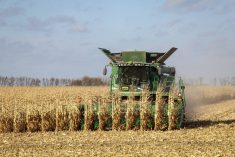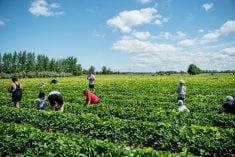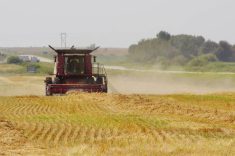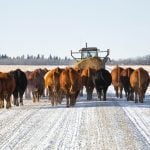Dicamba spray drift has been a talking point — or, for farmers on the wrong side of it, a cursing point — for as long as there have been crops tolerant to the Group 4 herbicide, allowing for in-season application.
It’s certainly been in the headlines since the 2010s, with surging Manitoba soybean acres and the emergence of Xtend technology bulletproofing some acres from damage, while the neighbour’s crops, under a non-tolerant variety remained susceptible.
The problem is, as far as drift risk goes, dicamba is a high-risk offender. It’s not just about the droplets. Dicamba tends to volatilize into vapour: hard to track and easily dispersed by wind.
Read Also

Still hard to predict precise fertilizer payback
Despite decades of advances, international research finds no clear answer for where and when adding nutrient will fail to boost growth.
WHY IT MATTERS: Dicamba-resistant genetics opened the door to new weed control options for soybean growers, but increased drift risk has also kept the chemistry in the hot seat.
Today, the most popular soybean varieties in Manitoba are marked as Roundup Ready 2 Xtend. That includes all of the five most planted varieties in 2024, according to the Manitoba Agricultural Services Corporation.
That doesn’t mean that there are no drift issues any more. The trait does not totally dominate the soybean variety list, and there are still plenty of susceptible broadleaf crops butting up against dicamba-treatable fields.
The herbicide has also run into controversy in the U.S. Last year, U.S. courts pumped the breaks on some dicamba-based product approvals from 2020, citing gaps in the U.S. Environmental Protection Agency’s procedure leading up to the approvals. Bayer Canada later noted that the U.S. decision had no bearing on Canadians’ ability to access impacted dicamba products.
What to do about dicamba
Tom Wolf, of spray research and training firm Agrimetrix, remains professional when talking about the pros and cons of dicamba. But he says the discussion always lands on the same conclusion: don’t spray it.
“We tend not to be quite so blunt in this. We tend to say everything but that, but I think when you put the pieces together, any thinking person would say, ‘Well, that’s probably the best thing to do,’” he said.
Wolf says the main problem with dicamba is its volatility. Particle spray drift is a consideration, as with any herbicide, but Wolf noted that “the chemical nature of the product is that it will evaporate and become a vapour under normal spraying conditions.”
Dicamba vapours can also come back from the dead.
“Dicamba and other volatile products will vapourize, even from a solid state, which means if they land on the plant or even on the soil and dry up to three or four days later, they will still be able to form a vapour from that dry deposit,” Wolf said.
Terry Buss, production agronomist with the Manitoba Pulse and Soybean Growers, takes a more moderate stance. Newer dicamba products have seen improvements that address some of those pitfalls, he said.
Bayer’s XtendiMax systems — to name one example — are marketed as relatively drift-resistant dicamba formulations along with their dicamba-tolerant soybean plants.
In other words, said Buss, not all dicamba products are created equal. Farmers need to do their homework.
“We call it dicamba, but you’ve got to be careful about what product you’re talking about,” he said.
“There is generic dicamba — it’s just your regular dicamba. It comes under a number of trade names. That is not a product that is supposed to be sprayed on soybeans,” he stressed.
“Old-fashioned dicamba can drift pretty readily (but) … the products that are made specifically for soybeans — which are the only ones that are supposed to be used — are less prone to drift.”
Reading the product labels can spare farmers a lot of headache, said Buss. “And when that’s combined with the way they’re labelled to be used in terms of droplet size and environmental conditions and production practices, they can be applied successfully and drift can be very much minimized.”
Smart dicamba decisions
Neither Wolf nor Buss have received many complaints of spray drift from dicamba coming off soybean fields in Manitoba this year.
Wolf noted there isn’t a lot of dicamba used in Manitoba, even on soybeans bred to tolerate the herbicide.
“It’s smaller than we expected, (but) that doesn’t mean we can brush it under the table,” he said on the topic of complaints. “When it happens to a farmer, it’s still serious.”
Signs of dicamba injury
Whether the drift comes from your own farm or from a neighbour, Wolf and Buss have some tips for managing dicamba spray drift. The first is scouting.
Possibly the best visual indicator of dicamba damage in soybeans is leaves that develop a “cupping” shape, said Wolf.
“It’s a very prominent leaf cupping,” he said.
“Soybean leaves are usually flat. They come in different sizes and shapes, of course, depending on the cultivar. But when they’ve been exposed to dicamba, they cup and they look like a spoon, basically, that’ll hold water. It’s a very strong tell-tale sign.”
Cupping isn’t necessarily the end of the world, Wolf noted.
“At low doses, the plant will actually outgrow it and not suffer any yield losses. So it could be more alarming on first inspection, but certainly yield losses are very possible.”
Apply early
Growers spraying dicamba are advised to do so before the heat comes, said Wolf. Heat increases volatility. However, volatility is difficult to prevent in a post-emergent spray.
“Maybe it was quite cold when you sprayed it. But if it gets really warm two or three days later, the volatility will still flare up and it will then cause damage,” he said.
Dicamba is best used on soybeans as a pre-seed application, he said.
“This would then prevent some damage to beans because they’re not yet growing. It would avoid some of the warm weather that often only comes later in the season.”
The old spray bane: inversions
Standard spray advice also applies.
Spray timing is key to preventing effects from atmospheric (or temperature) inversions. Wolf said those inversions occur in Manitoba on a nightly basis during the summer.
An inversion occurs when layers of warm air hover above layers of cool air, lowering atmospheric dispersion of all kinds of natural materials like dust, but also airborne spray droplets.
“It’s staying put. It’s hanging around. This is what the vapour would also do. And it would accumulate over the course of the night because it would not disperse,” said Wolf.
“And then in the early morning when the first little breeze comes up and the morning sun has risen, that concentrated cloud hanging over that recently-sprayed soybean field would move in the direction of that first prevailing wind, and then it will carry that vapour and cause that damage.”
Evenings and early morning are infamous for inversion risk. That sometimes leaves producers in a catch-22. If they go while the air is calm, there’s risk of an inversion. During the day though, winds often pick up. The dichotomy makes good spray days precious on the Prairies.
Assess and communicate
Vapour drift heads downwind, says Wolf. That’s why it’s crucial to determine where the plume is headed. If susceptible crops are in the crossfire, you may need to make a judgment call.
“(You) can tell what’s in ‘this’ field and sort of make a prediction about whether that field is at risk or not. If it’s unprotected soybeans (that are) not genetically-modified for dicamba resistance, then you should be super careful.
“If, however, it’s a plant like a cereal crop or something that can tolerate dicamba, you don’t have to be as careful, right? So you can kind of predict that.”
Wolf also urged producers to talk to their neighbours, including before they spray. Pre-application communication can not only save crops but create goodwill, he said.
If a grower thinks they’ve been hit by a neighbour’s drift, Buss also recommends dropping that farmer a line immediately.
“Find out the particulars of what they were doing on that field that you suspect it came from,” he said.
“Have an open conversation with them. Be constructive. Keep your emotions under check. I’ve found, overwhelmingly, farmers are more than willing to work with each other.”
Wolf agreed, adding that one option might be to place a flag in your field informing neighbours of what you’re doing.
“You would say ‘this’ soybean is resistant to Liberty, but not resistant to dicamba and it would kind of give a neighbouring farmer a heads-up. Maybe they’ll say, ‘Okay, I ought to be more careful here.’”
Ultimately, it comes down to being gracious when mistakes occur, said Buss.
“Be merciful, because someday you might do it to them without meaning to. Drift happens, and so let’s all be big boys and girls about this and treat each other mercifully, because no one’s trying to hurt you.”
















